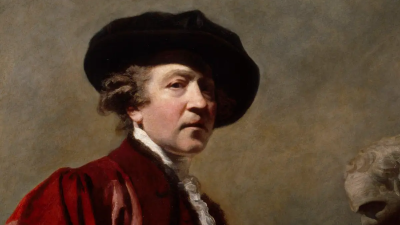
Norman Adams RA, Transfiguration, 1971.
Oil on canvas. 913 mm x 1218 mm x 18 mm. © Royal Academy of Arts. © Photo: Royal Academy of Arts, London.
This image is not available to download. To licence this image for commercial purposes, contact our Picture Library at picturelibrary@royalacademy.org.uk
Transfiguration, 1971
Norman Adams RA (1927 - 2005)
RA Collection: Art
Norman Adams was a painter, stage and costume designer, mural and ceramics artist, and teacher. Born in London, he studied at Harrow School of Art between 1940 and 1946, and at the Royal College of Art from 1948 to 1951, where he was awarded the Bronze Medal for Painting. One of the most renowned teachers of his generation, Adams began teaching part-time at St Albans School of Art in the 1950s. He subsequently held prestigious posts as Head of Painting at Manchester College of Art (1962-1970), visiting tutor at Leeds University (1973-1976) and Professor of Fine Art at the University of Newcastle (1981-1986). He was elected Keeper of the Royal Academy in 1986, where as an abstract artist he abolished compulsory life drawing, and was appointed the Academy's Professor of Painting Emeritus in 1995.
Adams’s first solo exhibition was held in 1952 at Gimpel Fils in London and biennial one-man shows were subsequently held from 1953 at Roland, Browse and Delbanco. He designed the stage set and costumes for the Royal Ballet’s A Mirror of Witches (1951), and the Sadler’s Wells production of Saudades (1953). Adams also completed several significant mural commissions, his first being for Broad Lane Comprehensive School, Coventry in 1954. In 1967 he was commissioned by the Oxford University Press to illustrate parts of the Old Testament.
Norman Adams’s Diploma Work, Transfiguration, is a study for one of a series of large abstract murals at the Church of St Anselm in Kennington, London, inspired by John Bunyan’s The Pilgrim’s Progress. Commissioned under the auspices of the Edwin Austin Mural Fund in 1971, and completed in 1972, the series is composed of ten panels, joined to form two murals, extending seventy feet on either side of the nave, to give a total length of 140 feet. The panels are abstract representations of the environment through which Christian travels on his spiritual journey, with the observer taking on the role of Christian. 1. The City of Destruction, 2. The Slough of Despond, 3. The House of the Interpreter, 4. Christian losing his burden at the sight of the Cross, 5. The Battle with Apollyon, 6. The Valley of the Shadow of Death, 7. The Land of the Giant of Despair, 8. The Land of Beulah, 9. The River of Death, 10. The Celestial City. Adams’s Diploma Work is a study for ‘The Land of Beulah’.
On his first visit to St Anselm’s, Adams was astonished at the size of the walls available to him. ‘This work was a marvellous opportunity,’ Adams recalled. ‘I was given a completely free hand. And I consider it to be my major achievement, a drawing together of many loose ends, and the most complete statement I have been able to make so far.’ [Recent Paintings. Including Studies for the Murals at St Anselm’s Church Kennington. Whitechapel Art Gallery, exhibition catalogue, 7th to 25th March 1973.]
Adams's engagement withThe Pilgrim's Progress dated back to the Second World War, when he was imprisoned in Wormwood Scrubs for six weeks as a conscientious objector. Adams was released into farm work for six days each week, and used his one free day to make illustrations for Bunyan's text. The book retained its significance for him when he returned to studying and took up a place at the Royal College of Art in 1946. Equally important to him was the Damascene moment he experienced when watching a black-and-white film on the life of Christ as told through Giotto’s paintings, in the Academy Cinema in Oxford Street. Although he never became a communicant in any denomination and sometimes called himself ‘a sort of free-lance agnostic’, he wanted to paint profoundly religious pictures, not just through specifically religious subjects but also in his paintings of the natural world.
Adams went on to make 14 ceramic panels of the Stations of the Cross for the Roman Catholic Church at Coffee Hall in Milton Keynes in 1975, and in 1994 he received another commission for the 14 Stations of the Cross, this time in oils, for St Mary’s Church, Mulberry Street, Manchester. After his death from Parkinson’s Disease in 2005, the Rt Rev Richard Harries observed that he became increasingly recognised as ‘a painter of profound spiritual significance’. In addition, he had become recognised as one of the liveliest forces in painting and in teaching.
Object details
913 mm x 1218 mm x 18 mm
Start exploring the RA Collection
- Explore art works, paint-smeared palettes, scribbled letters and more...
- Artists and architects have run the RA for 250 years.
Our Collection is a record of them.



